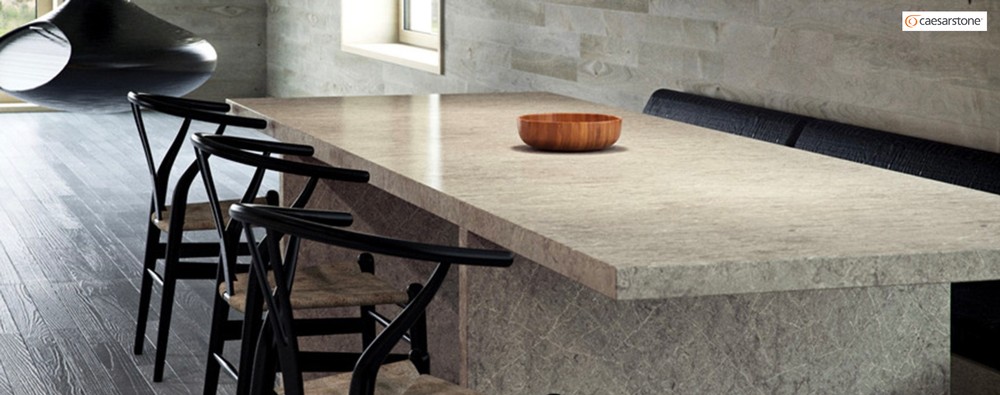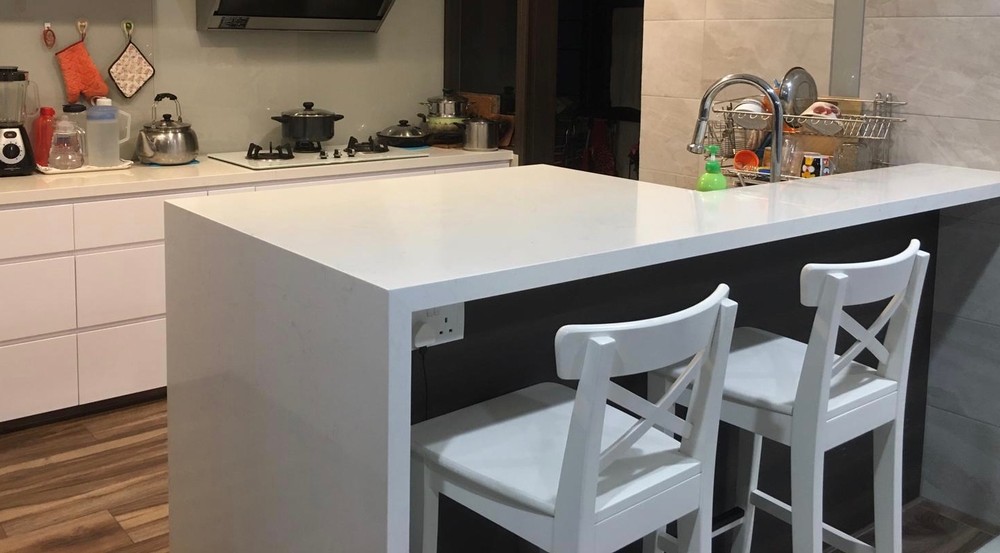Countertop Materials
Laminate, Marble/Granite, Solid Surface & Engineered Quartz

There are a number of write-ups by ID firms, contractors and materials suppliers about the various types of kitchen counter-top materials, their pros and cons and relative pricing. This article looks at kitchen countertop materials from the perspective of property owners, who have experienced their kitchen countertops being subjected to real-life heavy usage, and seek to draw some learning points that may help you when you renovate your kitchen.
More specifically, we look at the most commonly used countertop materials in Singapore – marble, granite, laminate, solid surface and engineered quartz. If you are currently thinking about renovating your kitchen, I hope you will find this article very useful.
We will start with some photos of counter-top materials after 8-15 years of real-life usage.
Laminate Countertop


According to the Freedonia Group, laminate is the most popular countertop material globally and they will account for 1/3 of worldwide countertop market share from 2015 to 2019.
Laminate is a composite artificial material made of kraft paper, decorative papers, and melamine resins, bonded through high heat and pressure. They are glued to MDF, plywood or particle board substrate to form the countertop, with special treatment for edges and cove (backsplash). Laminate countertop is the most economical countertop in the market.
Laminates are available in a wide variety of patterns that simulate appearance of wood, granite, marble, and other natural materials. They are fairly durable and scratch resistant, and modern laminates are fairly resistant to wear and tear, moisture and heat, when compared to veneer and wood. However, laminate countertops tend to warp or delaminate over time and when exposed to water. Some are also brittle and chipped relatively easily.
Maintenance of laminate is straightforward. Just clean with a mildly wet cloth and wipe dry. Do not use steel wool scrubbers or abrasive cleaner. And it is very important to protect the surface from exposure to excess water and direct sunlight.
To sum up, if you plan to work within a limited budget and you do not require a long working lifespan of the countertop, use laminate.
Local suppliers include Formica, Lamitak and EDL.
Natural Stones – Granite and Marble
Natural stones like granite and marble are 100% natural. Slab granite and marble counters are literally sliced from their quarries, cut to the correct size, and honed until they are smooth. As with any natural products, although it is indeed beautiful, natural stones have flaws and imperfections that you will either love or hate. Every slab is unique and no two pieces are the same.
Of the two, granite is the more durable stone. According to Mohs hardness scale where diamond has a hardness of 10, and chalk a hardness of 1 (http://www.specialtykitchens.com/mineral-hardness-scale), the hardness of marble and granite are:
•Marble 3-4
•Granite 6-7
•Natural Quartz 7
Granite's strength makes it suitable for kitchen countertops and floors, while marble is more appropriate in areas with less traffic, like bathrooms, where it can be used for vanities, tub decks, shower walls, and flooring.
We look at some photos of granite and marble after 8-15 years of use:




Natural stones (this applies to both granite and marble) are porous, and they are susceptible to stains when liquids spill on them — especially if the stones are left untreated. Sealants can help improve and prevent staining and etching on both marble and granite, but it is still best to wipe up problematic spills as quickly as possible. For marble surfaces, resealing is recommended twice a year, while for granite resealing once every two years should be sufficient. But how frequently either needs to be resealed depends on how heavily the surface is used. Lighter-colored granites, which are more porous, in general will require additional maintenance.
The following photos show that a granite top can remain beautiful and fresh, even after 10 years of use with daily cooking. This is achieved by proper care as well as resealing every two years.


Granite’s hard surface means that it is highly resistant to scratches. It is relatively unaffected by heat.
As marble is more porous, it is easier to stain and damage than granite overall. It is also more susceptible to acidic spills as well as heat than granite. Over time, marble naturally becomes duller. Unlike stains, which can sometimes be removed to some extent, the dulling of marble is an irreversible process.
Having said that, nothing beats the sheer elegance and luxurious feel of marble. If you have time to take care of marble, and can afford its high price, marble is a great choice for your home.
If you just like the look of the marble veins, an economical solution is to use laminates or solid surface, while an expensive option, but without the high maintenance of marble, would be quartz countertops.
The major suppliers of granite and marble in Singapore are Lian Hin, KStone and Stone Amperor.
Solid Surface
Have you every wonder why so many new condominium launches are using solid surfaces for their countertops and their vanity tops?
Solid surface has a more trendy and contemporary feel than marble or granite. Sinks can be under-mounted and backsplashes can be integrated into the top, making them seamless. There are hundreds of colors to choose from, and each year, many new colors and design are made available. Color trends are always changing and people change, too. Solid surface are able to keep up with these changes.



Solid-surface tops are usually made of acrylic, polyester together with fillers. They have great workability, and can be crafted into nearly any size and shape. They’re non-porous, thus making them ideal for food preparation, and will not support growth of mold and mildew when cleaned properly. Solid Surface chips and scratches much easier than laminate and natural stones. But as they’re of uniform material through and through, light scratches can be buffed out, deep scratches and burns can be sanded out, and severely damaged areas can literally be cut out and replaced.
The downside is that solid surface has a tendency to warp, melt, crack and/or discolor with even the most temporary contact with heat and hot objects. This includes hot pans, pots or even dishes. Sanding can eliminate all but the deepest scratches, but when it comes to warping and melting, your hands are tied.
If you want modern contemporary looks, easy to maintain and hygienic, at a relatively affordable price, solid surface is the choice for you.
For solid surface, the most popular ones are Corian from DuPont, Stone Ameror and Formica.

Engineered Quartz
An engineered quartz countertop can often be mistaken for one that is made of marble or granite. They can be created to look just as organic as the natural stone does, but without the hassle of annual sealing and maintenance. It is strong, durable and maintenance-free, making it the ideal material for kitchen countertop.
Engineered quartz comprises 93% natural quartz aggregates, combined with polyester resins to bind it and pigments to give it color and a uniform appearance. Natural quartz is one of the hardest minerals on Earth, with a Mohs Hardness rating of 7 (Chalk is 1, Diamond is 10, Marble is 3-5).

Engineered Quartz countertops are stain and scratch resistant — and they are nonporous. They never have to be sealed and are extremely bacteria-resistant. This makes quartz the perfect surface for food preparation and consumption. Quartz are also heat resistant up to 205 °C. There is a very broad range of colours and attractive designs; most styles mimic the look of stone like marble and granites, but you can also find funkier colors and patterns, as well as solid colors. Consumer Reports Magazine, a leading product review company, rated engineered quartz the highest overall score in the countertops material category.
However, in quartz countertop the seams will be visible, just like for granite and marble slabs. It is also a very expensive material, comparable to marble and granite.
Quartz can last a lifetime if treated properly. In fact, they literally pay for themselves since they add value to the home itself. It gives the kitchen a modern contemporary feel, and is a designer’s delight since it’s easy to work with, can flow with the rest of the kitchen and can turn any dull kitchen into a work of art immediately.
Finally, you may look at the chart below that compares the price of the materials discussed above, whether you want a traditional or a contemporary look for your kitchen. Feel free to drop a note to us if you feel that the article has benefited you, and feel free to refer your friends to this site and watch out for our next write-up on our “Landed Knowledge” series.
Common brands of engineered quartz in Singapore are iQuartz, Caesarstone, Silestone and Lian Hin.

